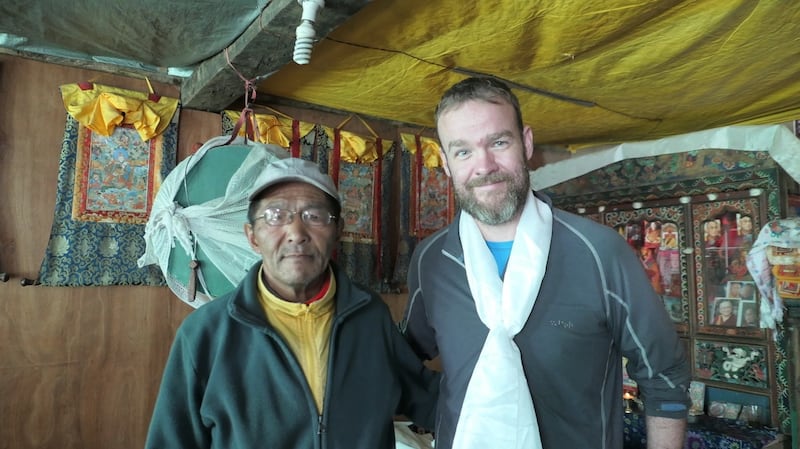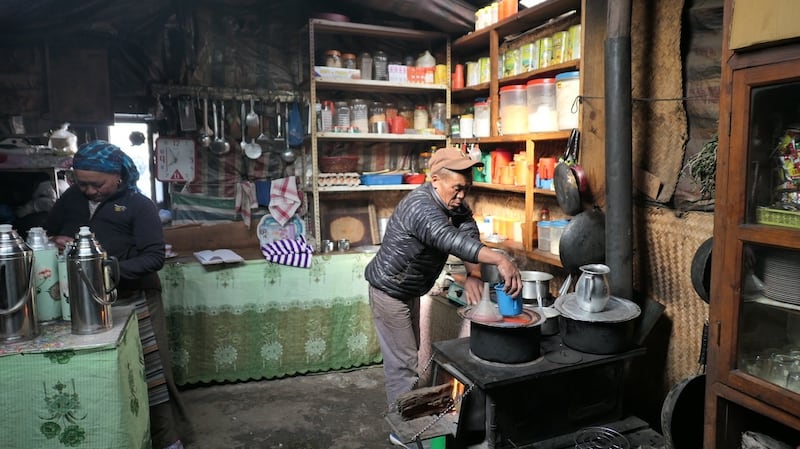“I’m feeling great,” I say. “Great” is a relative sensation at altitude. The dull throbbing pain at the back of my head last night is gone. The steady intake of fluids sorted that out. My light stomach upset has been going on for five days now, but my appetite is intact (or even thriving as I’ve been ordering two mains at every sitting). We’re in Gokyo at 4,750m now having crossed the Renjo La mountain pass at 5,330m earlier today.
Out of 13 of us on the trek thus far, 11 have experienced a headache in the last 24 hours, 10 have had some sort of stomach bug, six have had difficulty sleeping, four have missed a meal in the past two days, nine have had strangely vivid dreams, and 10 have experienced increased flatulence or “Hafe”, perhaps the least discussed high altitude condition.
Hafe – or high altitude flatus expulsion – is a gastrointestinal condition which involves passing increased amounts of gas at high altitude. With lower atmospheric pressure, the difference in pressure between gas in the body and outside is greater than at sea level and this creates an increased urge to expel the gas. It’s all been backed up by studies on military pilots, not made up by idle infantile mountaineers!


High-altitude expeditions are in part a test of your ability to cope with living in harsh conditions. Having just done our first high pass, the statistics above are not unusual. The stomach bugs are the result of drastic changes in diet and hygiene. People rarely survive a three-week trip through the Khumbu with their stomachs entirely intact. For those of us looking to summit – we know more coughs, headaches, poor sleep, crazy vivid dreams and nausea are all ahead.
Since leaving the Ama Dablam Lodge in Khangjuma we travelled up to Mong, then passed through Khumjung with its mani walls (stone carved with the Tibetan Buddhist chant "om mani padme hum" or "praise the jewel in the lotus") and then onto Thamo for lunch at Ang Chhutin Sherpa's lodge and restaurant.
Climbing Sherpani
Ang Chhutin Sherpa, daughter of eight-time Everest summiteer Ang Phurba Sherpa, was feeding her seven-month old daughter as we arrived. She is a remarkable woman and athlete. Winning the Everest marathon on her first attempt in 2014, she later ran in Singapore and Malaysia and then spent six months training in Berlin. She returned to Nepal to complete an Khumbu ice climbing course and other guide training to prepare to follow her father’s footsteps. There aren’t many climbing Sherpani and Tim Mosedale had hoped she would be joining his expeditions. She still plans to return to climbing in a couple of years and will hopefully one day summit Everest as a climbing Sherpani.
After lunch we continued up the valley to Thame where we stayed a couple of nights, climbing up to visit the local monastery above the village to receive blessings for the expedition ahead. In the afternoon, we broke out the Frisbee and a football made an appearance. Sport is a great culture and language barrier breaker – this was the first time we interacted with the porters in an informal setting.
We have nine porters and two local guides with us on the base camp trek. At base camp, we will meet our expedition Serdar, the climbing Sherpa, and our all-important cook crew.
Although the Sherpa are the best known of Nepal’s many indigenous groups, our porter crew are all from the Hinku valley below Lukla and from three other ethnic groups: the Rai, Chhetris, and Gurung. All come from farming communities and will be back in the fields for harvest come monsoon. They do an incredibly tough job supporting our expedition, and do so with remarkable courtesy and good humour.
Farming community
Laxman Rai (28) is one of our local guides. Orphaned at an early age, Laxman and his brother were brought up by their sister in the farming community of Gudel. He’s been working in the mountains since 2011 and last year worked as kitchen boy for Tim’s Everest expedition. Back home his wife is taking care of his two-year-old daughter and the farm with help from his brother. They grow corn, beans, potatoes and vegetables and own two cows, two pigs, and 10 chickens. Laxman wants to become a climber, but the Khumbu ice-climbing course and the climbing equipment is expensive so he’s hoping to get there within the next two years.
Dev Kumar is our other guide. At the age of 36, Dev has been portering for 19 years, and has had his Nepal guiding licence for the last six. His 18-year-old son Ramesh is also on the porter staff for this trip and sits excitedly next to his father as we chat about his village life in Sotang, a two-day walk down from Lukla. He jokes that they don’t have markets or airports or good schools down in their village. Also from a farming village, Dev’s wife and other son are looking after the farm and he’ll also be back with Ramesh for the busy monsoon season. Mainly their farming is for self-sufficiency and their porter income brings in all the extras. He says there are no lights in his village, they use kerosene lamps.
Leaving Thame the following morning, we stopped at Pasang Nuru Sherpa’s house in Thametung for tea as a few of us had bought his paintings the night before when he visited our tea house. Pasang lost all his fingers and toes while pinned down by a storm for five days while crossing the Nangpa La pass back in 1975. Pasang and his brother, who suffered similar fate, were the only surviving members of their travelling party. Pasang took up painting and has been doing it ever since. I bought a couple of pieces of the Khumbu valley and we received another blessing and white scarf put over our heads before going on our way. We also met Pasang’s 15-year-old son, who was waiting for exam results and hoping to be heading off to study hotel management at university in Kathmandu.
Word of mouth
We arrived in Marulung (4,210m) and found River View Lodge, owned and run by Ang Chhutin’s father Ang Phurba Sherpa. Phurba has summited Everest eight times, including once from the north side. We’d booked all seven rooms in his remote tea house for two days. There is no electricity, no communications to the outside world other than word of mouth and walking down the valley. For most people, it’s a full day’s walk to Namche Bazar, the nearest market town. Room bookings are routed through his daughter in Thamo and passed on by word of mouth, with someone inevitably having to make at least a half day’s walk. By luck, or perhaps through necessity, they are a family of marathon runners.
We were sitting in his small kitchen, from where he, his wife and second daughter Pasang (who had finished second to her sister in both the Everest marathon and ultramarathon in 2014) had just served all 15 of us a three-course meal. The menu was extensive but simple and revolved around potatoes, eggs, rice and noodles – a diet we are getting used to. We chatted about Phurba’s life. He started to work in the mountains when he was 20. He has worked with many of the world’s most famous mountaineers, including Reinhold Messner (first ascent of Everest without oxygen, first climber to complete all 14 peaks over 8,000m) and Hans Kammerlander (Italian mountaineer and skier who is known for his 8,000m climbs, speed records and ski descents).
On his last expedition in 2014, Phurba had climbed up through the Khumbu Icefall from base camp to Camp I on April 18th at 6.45am, when the radios went alive with chatter. A failed serac led to a massive avalanche which had just swept through the icefall and many Sherpa were still en route to Camp I. He picked up his gear and headed straight back down into the turmoil to help rescue survivors and get them to base camp for helicopter evacuation.
Lost lives
Sixteen Sherpa died that day. Out of respect for those who had lost their lives, the Sherpa climbing community announced they wouldn’t return to work on Everest for the remainder of the year and the climbing season was cancelled. It was Phurba’s last time on Everest, he lost many friends that day.
There is much talk about making more use of helicopters to reduce the need for Sherpa ferrying loads through the Khumbu Icefall but Phurba is adamant that while helicopters are invaluable for rescues, they are not appropriate for climbing. The Sherpa are, he maintains, skilled mountaineers, need the jobs and are proud to be such a key part of all climbing expeditions.
The next day we continued our acclimatisation schedule by climbing a nearby peak at 4970m and returned to Phurba’s lodge for another evening. We then headed up the valley to Lungde and on to Gokyo.
We're now 10 days away from base camp and acclimatising well. Over the next week we'll be dropping down to Phortse and taking a break in Dingboche before getting the tents out for the first time and trekking the Kongma La (5,545m) and making for an ascent of Pokalde (5,800m). * Rory McHugh is climbing Everest in aid of Rory's Nepal School Project with Child Rescue Nepal, to build schools in villages off the beaten track which have not yet recovered from the 2015 earthquake. He would also greatly appreciate your support on virginmoneygiving.com/letsbuildschools and on rorymchugh.com You can also follow his daily progress all the way to the summit through the Garmin mapping site: share.garmin.com/roryeverest











